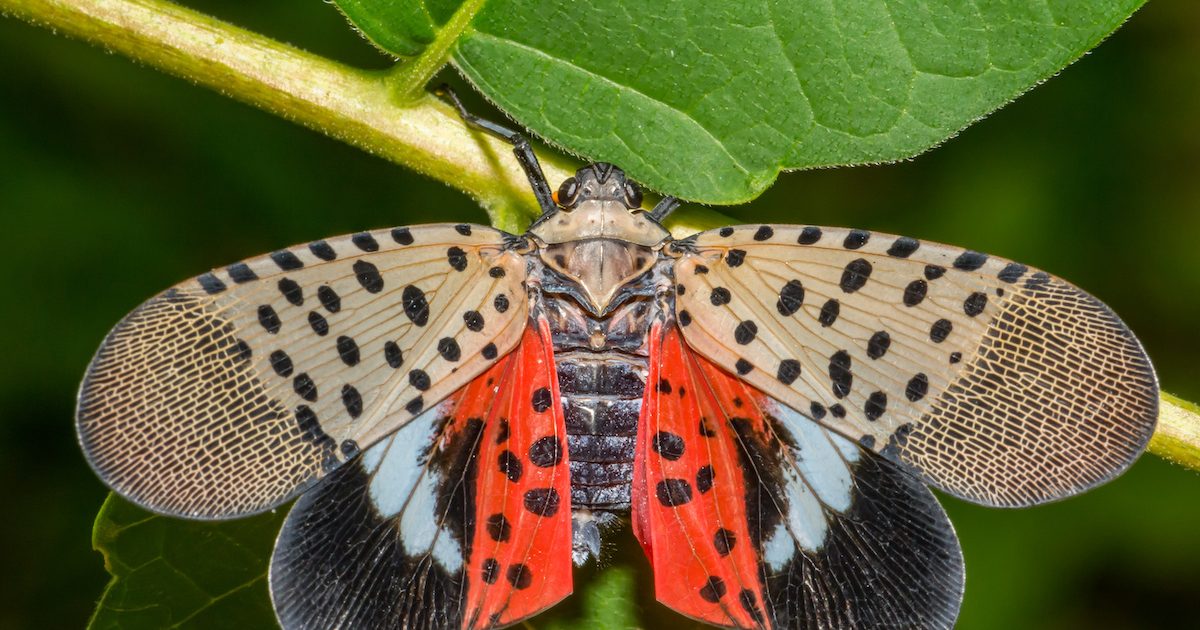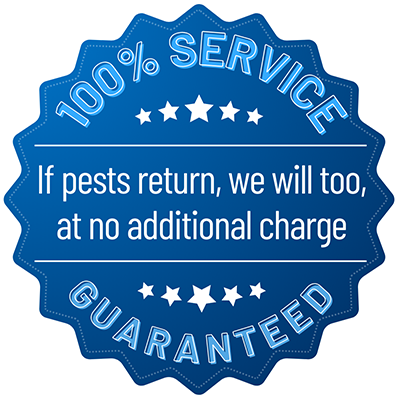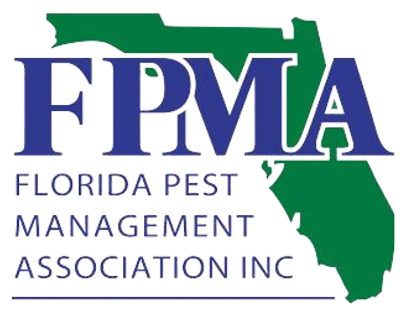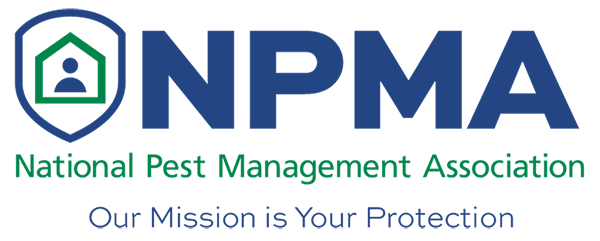
Have you heard of the Spotted Lantern Fly? You may not have seen one yet, but it’s an invasive species originating from Asia. This pest poses a significant threat to agriculture and the environment. You can find it in 14 states, but is Florida included? As the trusted exterminator in town, we’ll show you what you need to know about the Spotted Lantern Fly–and if you need to worry.
A Glimpse of the Spotted Lantern Fly
First, understand that the Spotted Lantern Fly is not an actual fly. In fact, it’s a planthopper that is related to cicadas and aphids. Here are some quick facts to learn about the Spotted Lantern Fly:
- Origins: The Spotted Lantern Fly hails from China, India, and Vietnam. It was first discovered in the United States in Pennsylvania in 2014.
- Appearance: As its name suggests, this bug is easily identifiable by its spotted wings. Its hind wings are red with black spots on the front part. Meanwhile, it has a white band in the middle, while its front wings are gray with black spots.
- Lifecycle: It has a unique life cycle. Adults lay eggs in the fall. Their young, known as nymphs, hatching in the spring.
- Favorite Hosts: The Spotted Lantern Fly prefers Tree of Heaven (Ailanthus altissima), but it can feed on a variety of other plants, trees, and crops.
The Spotted Lantern Fly in Florida: Current Situation
As of now, there are no official reports of the Spotted Lantern Fly establishing a presence in Florida. This is great news! Florida’s climate and abundant agricultural lands could potentially provide a favorable environment for this pest. For now, we are lucky to not have this pest here in the sunshine state. But this doesn’t mean that it won’t eventually find its way here to Florida.
Potential Impact of the Spotted Lantern Fly in Florida
Although the Spotted Lantern Fly has not yet reached Florida, it’s essential to understand the possible impacts if it does. It can greatly impact the following categories of our state:
- Agriculture: The Spotted Lantern Fly feeds on a wide variety of plants, with a particular preference for grapes, hops, and hardwoods. This feeding habit could pose a significant threat to Florida’s vital citrus industry, as well as other agricultural products.
- Ecosystem: An infestation could also disrupt the local ecosystem, impacting both plant and animal life.
- Quality of Life: In areas where they are prevalent, these pests can swarm in large numbers, leading to inconvenience and discomfort for residents.
Agriculture and Crops
Florida is known for its diverse and thriving agricultural sector, a vital component of the state’s economy. The Sunshine State is a top producer of a variety of crops, including:
- Citrus fruits
- Strawberries
- Tomatoes
- Sugarcane
- A wide array of ornamental plants.
The possible invasion of the Spotted Lantern Fly, are taken very seriously. Here’s a deeper look at how this pest could potentially impact Florida’s agriculture.
Threat to Citrus Industry
Florida is synonymous with orange juice, being one of the world’s leading producers of citrus, particularly oranges. The Spotted Lantern Fly feeds on a broad spectrum of plants. Meanwhile, citrus trees could potentially be on their menu. An infestation may lead to diminished health of the trees, loss of fruit, and potentially a devastating blow to the citrus industry.
Damage to Other Crops
Although citrus is a significant part of Florida’s agriculture, it’s not the only crop that could be at risk. The Spotted Lantern Fly also feeds on grapes, hops, stone fruits, and a variety of hardwood trees. Florida’s burgeoning wine industry may also face significant losses. Similarly, hardwood trees used in the timber industry and hops used in the growing craft beer industry could be negatively impacted.
Risk to Ornamental Plants
Florida is a leading producer of ornamental plants. These plants, including a variety of trees, shrubs, and flowers, add to Florida’s beauty and are a significant export. The Spotted Lantern Fly poses a direct threat to this industry as well, as it has a broad host range and can feed on many different plant species.
Potential Economic Impact
Agriculture is a cornerstone of Florida’s economy. A large-scale invasion by the Spotted Lantern Fly could potentially cost millions in lost revenue and eradication efforts.
How Might the Spotted Lantern Fly Hurt Florida’s Ecosystem?
Florida’s ecosystems are some of the most unique and diverse in the world. From the Everglades’ sprawling wetlands to the vibrant coral reefs off the coast, these ecosystems support a wide array of plant and animal species. An invasive species like the Spotted Lantern Fly could significantly disrupt these delicate balances.
Threat to Native Florida
The Spotted Lantern Fly is a sap-feeding insect that feasts on a broad range of host plants. This extensive diet means it could potentially impact many native plant species in Florida. A decrease in plant health due to Lantern Fly feeding could lead to reduced biodiversity. Meanwhile, this can lead to changes in the local ecosystems. This can potentially lead to the decline or disappearance of certain plant species.
Disruption of Food Chains
The Spotted Lantern Fly’s potential impact on plant health doesn’t just affect the plants themselves. Plants form the base of most food chains. If the Lantern Fly reduces the abundance or health of certain plant species, it can impact the whole food chain. Herbivores that feed on these plants may find less food available, and their populations may decline as a result.
This can then affect predators that rely on these herbivores for food, causing ripple effects throughout the ecosystem.
Increased SooTew (Sooty Mold)
The Spotted Lantern Fly, like many sap-feeding insects, excretes a sugary substance known as honeydew. This honeydew can promote the growth of sooty mold, a black fungus that can cover the leaves of plants. This not only reduces the plant’s aesthetic value but can also inhibit photosynthesis.
Potential Spread of Disease
While it’s not yet known if the Spotted Lantern Fly can spread plant diseases, other sap-feeding insects have been known to do so. However, they may be toxic to pets. If the Lantern Fly proves capable of spreading disease, it could introduce new threats to Florida’s native plants, compounding the impacts on the ecosystem.
Ecosystems Concerns
Florida’s ecosystems are some of the most unique and diverse in the world. From the Everglades’ sprawling wetlands to the vibrant coral reefs off the coast, these ecosystems support a wide array of plant and animal species. An invasive species like the Spotted Lantern Fly could significantly disrupt these delicate balances. Let’s explore how.
Increased SooTew (Sooty Mold)
The Spotted Lantern Fly, like many sap-feeding insects, excretes a sugary substance known as honeydew. This honeydew can promote the growth of sooty mold, a black fungus that can cover the leaves of plants. This not only reduces the plant’s aesthetic value but can also inhibit photosynthesis, affecting the plant’s health and growth. This could impact plant populations and alter habitat structures.
Potential Spread of Disease
While it’s not yet known if the Spotted Lantern Fly can spread plant diseases, other sap-feeding insects have been known to do so. If the Lantern Fly proves capable of spreading disease, it could introduce new threats to Florida’s native plants, compounding the impacts on the ecosystem.
At this point, it’s crucial to remain vigilant rather than worried. Florida’s Department of Agriculture and Consumer Services (FDACS) is closely monitoring the situation. As of now, no sightings of the Spotted Lantern Fly have been confirmed in the state as of mid-2023.
However, it’s essential to understand what this pest looks like and to report any potential sightings to FDACS. Early detection can play a key role in preventing the establishment of the Spotted Lantern Fly in Florida.
If you spot a Spotted Lantern Fly in Florida, be sure to call FDACS at (407) 888-8700.






